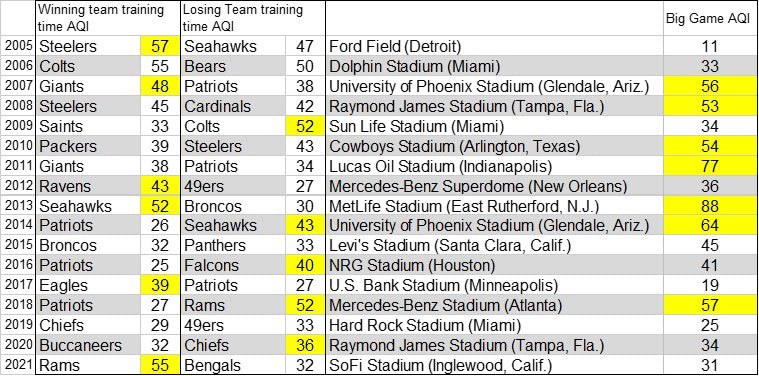Air quality is a factor in any game, but just how much can be hard to tell. Pollution can cause a wide variety of problems, including degrading athletic performance. Some doctors even recommend that people who live in cities avoid exercise during commute hours in the morning and evening. A study on more than a decade of soccer in Germany found that more pollution in the air made players less productive, in that they passed the ball fewer times. The effects were more pronounced in older players and for positions that required more or longer physical effort.
Not only does air quality have an impact on players, more people are likely to drive to playoff or championship games. At the collegiate level the extra car exhaust can make the local air quality as much as 20 times worse than the recommended exposure levels. To make things even more complicated, every team practices in a different city so may be more or less affected by air pollution throughout the year. Let’s look into how bad it really is to breathe air pollution while exercising and what kind of impact it can have in the long term.
When is breathing air pollution worse than exercising?
Breathing bad air affects your lungs and heart the most because those are the first organs that are attacked. After you inhale, the particles and gasses that make up air pollution go into your lungs, then pass into the blood along with oxygen. The first stop after the lungs is the heart, which pumps freshly oxygenated blood throughout your body with the contaminants tagging along.
But don’t keep a constant watch on the AQI levels before you go to the gym or for a jog. If you just want to be fit so you can live longer, most of the benefits of being fit come in the first 30 minutes of exercise, and there is little benefit for the average person beyond 60 minutes a day. When looking at a detailed study on walking, cycling, and the impact of air quality, one research team found that only extremely bad air quality warrants not exercising for 30 or 60 minutes:
-
Biking for…
- one hour when the AQI is less than 150 (orange, unhealthy for sensitive groups) is only beneficial and not harmful.
- one hour when the AQI is over 240 (purple, very unhealthy) does more harm than good.
- thirty minutes when the AQI is under 210 (purple, very unhealthy) is only beneficial and not harmful.
- thirty minutes is beneficial until the AQI is off the scale.
-
Walking for…
- one hour when the AQI is less than 450 (maroon, hazardous) is only beneficial and not harmful.
- one hour is always beneficial regardless of the AQI.
- thirty minutes is always beneficial regardless of the AQI.
This is a little different for professional athletes, who don’t just exercise because it’s good for you, they need many hours of intense training every day to perform at the level of their peers. The study above notes that four or more hours of exercise in anything other than a green and good AQI could do more harm than good. Fortunately sports scores and AQI levels are readily available data points, as we’ll see in the next section.
Can air quality really impact player performance?
It is quite possible and even likely that air pollution has changed the scores of a few professional games. A study in China on two full seasons of soccer matches looked at the air quality of where teams practice versus where they played. They found that players can adapt to pollution, and the biggest impact hit players who were not adapted to bad air quality on game day.
The study certainly had some limitations, but measured more than 12,000 passes and possessions so can be relied on for some indication of the impact of air quality. The biggest caveat in the study is definitely that factors such as home team advantage or overall player skill dwarf the impact of air quality as much as 5 times. For example the authors note that poor air quality might decrease the chances of a non-adapted team of winning by 10%, but that home team advantage can double the chances of winning.
So how will this factor into this year’s Big Game?
The EPA offers all of the air quality data they have collected over the years to the public, so we took a look at the air quality of the teams that played and if that followed any of the adaptation patterns seen in the Chinese Soccer players.
The table below shows the average AQI for each team’s city from August to December, which is the primary time the team would be training and playing leading up to the championship game. We tested the average AQIs against each other using statistical techniques that weed out errors, so if the team’s AQI is highlighted it’s significantly higher than the other team with 95% confidence. Highlighted game day AQIs are over 50, indicating less than good air quality.

The numbers barely show the impact of air quality adaptation. Of the teams with different AQIs, 6 with high AQIs won and 5 with high AQIs won. Of the 4 championship games when the AQI was high and teams had different AQIs during training, 2 with high AQIs won and 2 with high AQIs lost. The effect might be more obvious looking at more games, but at least for these games AQI didn’t have a big effect.
Not only is AQI unlikely to affect the game, but it is being played in Phoenix, Arizona, where the air is very good until fire season in April or May. We all will need to look at other factors as we predict who will be the champion.







